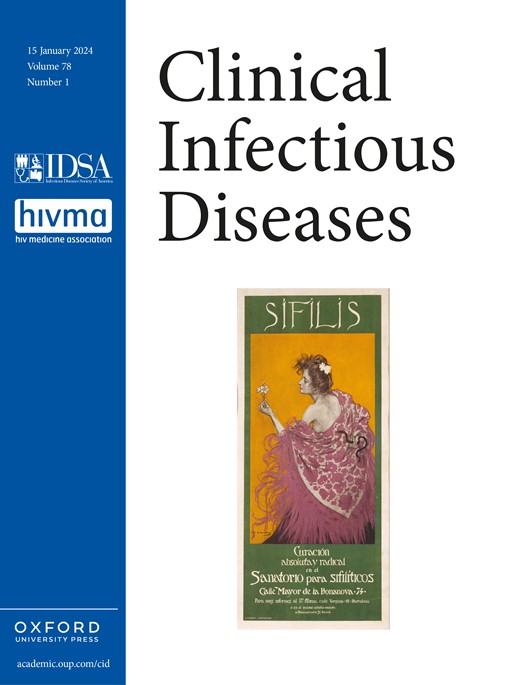预测移民到结核病发病率低的国家的人患结核病的风险:利用卫生行政数据开发和验证多变量动态风险预测模型
IF 8.2
1区 医学
Q1 IMMUNOLOGY
引用次数: 0
摘要
背景 移民到加拿大和其他结核病发病率较低的国家的人结核病(TB)发病率仍然过高,但对移民进行系统的结核病筛查和预防对结核病项目来说往往成本过高。我们的目标是开发并验证一种结核病风险预测模型,为加拿大外国出生永久居民的结核病筛查决策提供依据。方法 我们利用不列颠哥伦比亚省和安大略省(加拿大两个不同的省级医疗保健系统)的卫生行政数据,开发并验证了一个用于结核病风险预测的比例基线地标超模型。在不列颠哥伦比亚省,我们使用人口统计学变量(年龄、性别、难民身份、入境年份、原籍国结核病发病率)、结核病暴露变量和医学变量(艾滋病、肾病、糖尿病、实体器官移植、癌症)来推导和测试模型;在安大略省队列中,我们选择了一个模型进行外部验证。该模型预测安大略省队列中 2 年和 5 年肺结核风险的能力通过判别和校准统计进行评估。结果 研究纳入了不列颠哥伦比亚省衍生队列中的 715,423 人(包括 1,407 名结核病患者)和安大略省验证队列中的 958,131 人(包括 1,361 名结核病患者)。验证队列中的 2 年和 5 年一致性统计量分别为 0.77(95%CI:0.75-0.78)和 0.77(95%CI:0.76-0.78)。在 2 年和 5 年的预测窗口中,大样本校准值分别为 0.14(95% CI:0.08-0.21)和-0.05(95% CI:-0.12-0.02)。结论 该预测模型可在 https://tb-migrate.com 上在线查阅,它可以改善移民到低发病率国家的人的结核病风险分层,并有助于为结核病筛查政策和指南提供信息。本文章由计算机程序翻译,如有差异,请以英文原文为准。
Predicting risk of tuberculosis disease in people migrating to a low-TB incidence country: development and validation of a multivariable dynamic risk prediction model using health administrative data
Background Tuberculosis (TB) incidence remains disproportionately high in people migrating to Canada and other low TB incidence countries, but systematic TB screening and prevention in migrants is often cost-prohibitive for TB programs. We aimed to develop and validate a TB risk prediction model to inform TB screening decisions in foreign-born permanent residents of Canada. Methods We developed and validated a proportional baselines landmark supermodel for TB risk prediction using health administrative data from British Columbia and Ontario, two distinct provincial healthcare systems in Canada. Demographic (age, sex, refugee status, year of entry, TB incidence in country of origin), TB exposure, and medical (HIV, kidney disease, diabetes, solid organ transplantation, cancer) covariates were used to derive and test models in British Columbia; one model was chosen for external validation in the Ontario cohort. The model’s ability to predict 2- and 5-year TB risk in the Ontario cohort was assessed using discrimination and calibration statistics. Results The study included 715,423 individuals (including 1,407 people with TB disease) in the British Columbia derivation cohort, and 958,131 individuals (including 1,361 people with TB disease) in the Ontario validation cohort. The 2- and 5-year concordance statistic in the validation cohort was 0.77 (95%CI: 0.75-0.78) and 0.77 (95%CI: 0.76-0.78), respectively. Calibration-in-the-large values were 0.14 (95% CI: 0.08-0.21) and -0.05 (95% CI: -0.12-0.02) in 2- and 5-year prediction windows. Conclusions This prediction model, available online at https://tb-migrate.com, may improve TB risk stratification in people migrating to low incidence countries and may help inform TB screening policy and guidelines.
求助全文
通过发布文献求助,成功后即可免费获取论文全文。
去求助
来源期刊

Clinical Infectious Diseases
医学-传染病学
CiteScore
25.00
自引率
2.50%
发文量
900
审稿时长
3 months
期刊介绍:
Clinical Infectious Diseases (CID) is dedicated to publishing original research, reviews, guidelines, and perspectives with the potential to reshape clinical practice, providing clinicians with valuable insights for patient care. CID comprehensively addresses the clinical presentation, diagnosis, treatment, and prevention of a wide spectrum of infectious diseases. The journal places a high priority on the assessment of current and innovative treatments, microbiology, immunology, and policies, ensuring relevance to patient care in its commitment to advancing the field of infectious diseases.
 求助内容:
求助内容: 应助结果提醒方式:
应助结果提醒方式:


